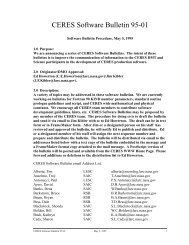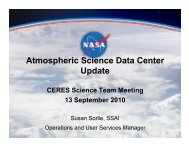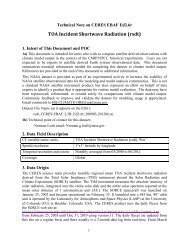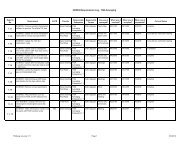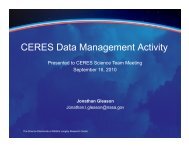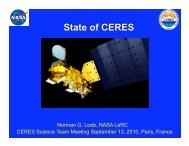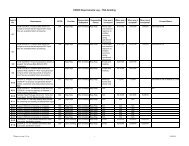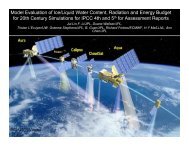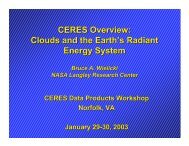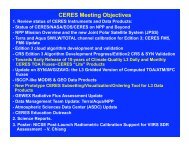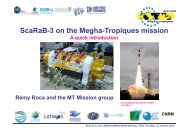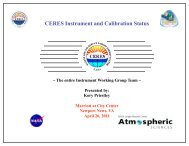Create successful ePaper yourself
Turn your PDF publications into a flip-book with our unique Google optimized e-Paper software.
<strong>Planetary</strong> <strong>Radiation</strong> <strong>Budgets</strong><br />
Robert Kandel and Michel Viollier<br />
Laboratoire de Météorologie Dynamique<br />
LMD – IPSL, Ecole Polytechnique<br />
Palaiseau, France<br />
CERES STM<br />
23-25 Sept. 2003<br />
R. Kandel & M. Viollier<br />
<strong>Planetary</strong> <strong>Radiation</strong> <strong>Budgets</strong><br />
1
<strong>Radiation</strong> Balance : R N =<br />
absorbed SW flux – emitted LW flux<br />
(averaged over the planetary surface)<br />
CERES STM<br />
23-25 Sept. 2003<br />
Energy Balance : R N – P = 0<br />
P = average energy flux from the planetary interior<br />
R. Kandel & M. Viollier<br />
<strong>Planetary</strong> <strong>Radiation</strong> <strong>Budgets</strong><br />
2
Absorbed SW flux = ¼ ( S 0 /a 2 ) ( 1 – A )<br />
Bond Albedo A =<br />
mean reflected SW flux<br />
mean incident SW flux<br />
(Means over planet’s entire surface)<br />
CERES STM<br />
23-25 Sept. 2003<br />
R. Kandel & M. Viollier<br />
<strong>Planetary</strong> <strong>Radiation</strong> <strong>Budgets</strong><br />
3
Z<br />
q S<br />
q v<br />
f v<br />
CERES STM<br />
23-25 Sept. 2003<br />
R. Kandel & M. Viollier<br />
<strong>Planetary</strong> <strong>Radiation</strong> <strong>Budgets</strong><br />
4
Each radiance measured<br />
(e.g. from A or N)<br />
is a single sample of<br />
directions (q S ; q v , f v )<br />
contributing to the fluxes<br />
emerging at those points.<br />
P<br />
A<br />
N<br />
P’<br />
CERES STM<br />
23-25 Sept. 2003<br />
R. Kandel & M. Viollier<br />
<strong>Planetary</strong> <strong>Radiation</strong> <strong>Budgets</strong><br />
5
Each radiance measured (e.g. from A or N) is a<br />
single sample of directions (q S ; q v , f v ) contributing to<br />
the fluxes emerging at those points.<br />
The flux measured<br />
with WFOV results<br />
from radiances from<br />
points N, A, P, P’, etc.<br />
each with its set of<br />
angles, each more or<br />
less representative of<br />
the flux emerging at<br />
those points.<br />
P<br />
A<br />
CERES STM<br />
23-25 Sept. 2003<br />
N<br />
P’<br />
R. Kandel & M. Viollier<br />
<strong>Planetary</strong> <strong>Radiation</strong> <strong>Budgets</strong><br />
6<br />
CERES STM<br />
23-25 Sept. 2003<br />
R. Kandel & M. Viollier<br />
<strong>Planetary</strong> <strong>Radiation</strong> <strong>Budgets</strong><br />
6
Replacing the satellite by a much<br />
more remote observer, say on<br />
another planet –<br />
It’s the same problem<br />
Observer<br />
P<br />
A<br />
N<br />
Observed<br />
planet<br />
CERES STM<br />
23-25 Sept. 2003<br />
P’<br />
R. Kandel & M. Viollier<br />
<strong>Planetary</strong> <strong>Radiation</strong> <strong>Budgets</strong><br />
6<br />
CERES STM<br />
23-25 Sept. 2003<br />
R. Kandel & M. Viollier<br />
<strong>Planetary</strong> <strong>Radiation</strong> <strong>Budgets</strong><br />
7
CERES STM<br />
23-25 Sept. 2003<br />
R. Kandel & M. Viollier<br />
<strong>Planetary</strong> <strong>Radiation</strong> <strong>Budgets</strong><br />
8
VENUS<br />
b V<br />
EARTH<br />
SUN<br />
b M<br />
CERES STM<br />
23-25 Sept. 2003<br />
MARS<br />
R. Kandel & M. Viollier<br />
<strong>Planetary</strong> <strong>Radiation</strong> <strong>Budgets</strong><br />
9
Bond Albedo Estimates Old and New<br />
Allen Chamberlain<br />
PLANET<br />
1955<br />
1979<br />
1999<br />
2002<br />
TCAEP<br />
NSSDC<br />
Mercury<br />
0.060<br />
0.056<br />
0.06<br />
0.06<br />
0.119<br />
0.119<br />
Venus<br />
0.61<br />
0.72<br />
0.72<br />
0.76<br />
0.750<br />
0.750<br />
EARTH<br />
0.34<br />
0.39<br />
0.39<br />
0.40<br />
0.304<br />
0.304<br />
Mars<br />
0.15<br />
0.16<br />
0.16<br />
0.16<br />
0.16<br />
0.250<br />
Jupiter<br />
0.41<br />
0.45<br />
0.70<br />
0.51<br />
0.70<br />
0.343<br />
Saturn<br />
0.42<br />
0.75<br />
0.75<br />
0.50<br />
0.75<br />
0.342<br />
Uranus<br />
0.45<br />
0.90<br />
0.90<br />
0.66<br />
0.90<br />
0.30<br />
Neptune<br />
0.54<br />
0.82<br />
0.82<br />
0.62<br />
0.82<br />
0.29<br />
Pluto<br />
0.16<br />
0.15<br />
0.15<br />
0.50<br />
0.145<br />
0.4-6<br />
CERES STM<br />
23-25 Sept. 2003<br />
R. Kandel & M. Viollier<br />
<strong>Planetary</strong> <strong>Radiation</strong> <strong>Budgets</strong><br />
10
PLANET<br />
Mercury<br />
Venus<br />
EARTH<br />
Mars<br />
Jupiter<br />
Saturn<br />
Uranus<br />
Neptune<br />
Pluto<br />
Bond Albedo Estimates Old and New<br />
1955<br />
0.060<br />
0.61<br />
0.34<br />
0.150<br />
0.41<br />
0.42<br />
0.45<br />
0.54<br />
0.16<br />
1979<br />
0.056<br />
0.72<br />
0.39<br />
0.16<br />
0.45<br />
0.75<br />
0.90<br />
0.82<br />
0.15<br />
Astronomy<br />
textbook Univ. Website 2003 ?!?<br />
1999<br />
0.06<br />
0.72<br />
0.39<br />
0.16<br />
0.70<br />
0.75<br />
0.90<br />
0.82<br />
0.15<br />
2002<br />
0.06<br />
0.76<br />
0.40<br />
0.16<br />
0.51<br />
0.50<br />
0.66<br />
0.62<br />
0.50<br />
TCAEP<br />
0.119<br />
0.750<br />
0.304<br />
0.16<br />
0.70<br />
0.75<br />
0.90<br />
0.82<br />
0.145<br />
NSSDC<br />
0.119<br />
0.750<br />
0.304<br />
0.250<br />
0.343<br />
0.342<br />
0.30<br />
0.29<br />
0.4-6<br />
?!<br />
CERES STM<br />
23-25 Sept. 2003<br />
R. Kandel & M. Viollier<br />
<strong>Planetary</strong> <strong>Radiation</strong> <strong>Budgets</strong><br />
11
Bond albedo A = p q<br />
both geometric albedo p and phase integral q have changed<br />
geometric albedo p =<br />
planet’s brightness at Sun angle β = 0<br />
brightness of a perfectly diffusing disk of same size<br />
VENUS<br />
b V<br />
EARTH<br />
SUN<br />
b M<br />
phase integral<br />
q<br />
=<br />
2<br />
π<br />
∫<br />
0<br />
[ L( β )/<br />
L(0)<br />
] sin β dβ<br />
MARS<br />
CERES STM<br />
23-25 Sept. 2003<br />
R. Kandel & M. Viollier<br />
<strong>Planetary</strong> <strong>Radiation</strong> <strong>Budgets</strong><br />
9<br />
CERES STM<br />
23-25 Sept. 2003<br />
R. Kandel & M. Viollier<br />
<strong>Planetary</strong> <strong>Radiation</strong> <strong>Budgets</strong><br />
12
Bond albedo A = p q<br />
both geometric albedo p and phase integral q have changed<br />
Allen 1955<br />
NSSDC 2003<br />
Planet<br />
p<br />
q<br />
A<br />
p<br />
q<br />
A<br />
Mercury<br />
0.093<br />
0.65<br />
0.060<br />
0.106<br />
1.12<br />
0.119<br />
Venus<br />
0.49<br />
1.24<br />
0.61<br />
0.65<br />
1.15<br />
0.750<br />
EARTH<br />
0.34<br />
1.00<br />
0.34<br />
0.367<br />
0.83<br />
0.306<br />
Mars<br />
0.136<br />
1.10<br />
0.150<br />
0.150<br />
1.67<br />
0.250<br />
Jupiter<br />
0.37<br />
1.11<br />
0.41<br />
0.52<br />
0.66<br />
0.343<br />
Saturn<br />
0.42<br />
1.00<br />
0.42<br />
0.47<br />
0.73<br />
0.342<br />
Uranus<br />
0.41<br />
1.10<br />
0.45<br />
0.51<br />
0.59<br />
0.300<br />
Neptune<br />
0.50<br />
1.08<br />
0.54<br />
0.41<br />
0.71<br />
0.290<br />
Pluto<br />
0.16<br />
1.00<br />
0.16<br />
0.5-<br />
0.7<br />
0.8<br />
0.4-<br />
0.6<br />
CERES STM<br />
23-25 Sept. 2003<br />
R. Kandel & M. Viollier<br />
<strong>Planetary</strong> <strong>Radiation</strong> <strong>Budgets</strong><br />
13
Ground-based Earth albedo ?<br />
Replacing the satellite by an<br />
observer, on the Moon –<br />
It’s still the same problem,<br />
but worse<br />
Moon<br />
P<br />
A<br />
N<br />
P’<br />
Earth<br />
CERES STM<br />
23-25 Sept. 2003<br />
R. Kandel & M. Viollier<br />
<strong>Planetary</strong> <strong>Radiation</strong> <strong>Budgets</strong><br />
6<br />
CERES STM<br />
23-25 Sept. 2003<br />
R. Kandel & M. Viollier<br />
<strong>Planetary</strong> <strong>Radiation</strong> <strong>Budgets</strong><br />
14
Bond albedo A = p q<br />
both geometric albedo p and phase integral q have changed<br />
Allen 1955<br />
NSSDC 2003<br />
Planet<br />
p<br />
q<br />
A<br />
p<br />
q<br />
A<br />
Mercury<br />
0.093<br />
0.65<br />
0.060<br />
0.106<br />
1.12<br />
0.119<br />
Venus<br />
0.49<br />
1.24<br />
0.61<br />
0.65<br />
1.15<br />
0.750<br />
EARTH<br />
0.34<br />
1.00<br />
0.34<br />
0.367<br />
0.83<br />
0.306<br />
Mars<br />
0.136<br />
1.10<br />
0.150<br />
0.150<br />
1.67<br />
0.250<br />
Jupiter<br />
0.37<br />
1.11<br />
0.41<br />
0.52<br />
0.66<br />
0.343<br />
Saturn<br />
0.42<br />
1.00<br />
0.42<br />
0.47<br />
0.73<br />
0.342<br />
Uranus<br />
0.41<br />
1.10<br />
0.45<br />
0.51<br />
0.59<br />
0.300<br />
Neptune<br />
0.50<br />
1.08<br />
0.54<br />
0.41<br />
0.71<br />
0.290<br />
Pluto<br />
0.16<br />
1.00<br />
0.16<br />
0.5-<br />
0.7<br />
0.8<br />
0.4-<br />
0.6<br />
CERES STM<br />
23-25 Sept. 2003<br />
R. Kandel & M. Viollier<br />
<strong>Planetary</strong> <strong>Radiation</strong> <strong>Budgets</strong><br />
15
<strong>Radiation</strong> Balance<br />
R N = absorbed SW flux – emitted LW flux<br />
CERES STM<br />
23-25 Sept. 2003<br />
R. Kandel & M. Viollier<br />
<strong>Planetary</strong> <strong>Radiation</strong> <strong>Budgets</strong><br />
16
<strong>Radiation</strong> Balance<br />
R N = absorbed SW flux – emitted LW flux<br />
CERES STM<br />
23-25 Sept. 2003<br />
R. Kandel & M. Viollier<br />
<strong>Planetary</strong> <strong>Radiation</strong> <strong>Budgets</strong><br />
17
Earth’s Energy Balance :<br />
342 incident SW flux<br />
102 reflected<br />
SW flux<br />
NOT 137<br />
R N - P = 0<br />
240 LW flux<br />
to space<br />
absorbed SW flux<br />
Energy Balance = 240 : R N - P = 0<br />
P = 0.086<br />
CERES STM<br />
23-25 Sept. 2003<br />
R. Kandel & M. Viollier<br />
<strong>Planetary</strong> <strong>Radiation</strong> <strong>Budgets</strong><br />
618
Jupiter’s Energy Balance :<br />
12.6 incident SW flux<br />
4.3 reflected<br />
SW flux<br />
or 8.8 ?!<br />
R N - P = 0<br />
13.6 LW flux<br />
to space<br />
absorbed SW flux<br />
= 8.3<br />
Energy<br />
or is<br />
Balance<br />
it 3.8 ?!<br />
: R N - P = 0<br />
P = 5.3… or 9.8 ?!<br />
CERES STM<br />
23-25 Sept. 2003<br />
R. Kandel & M. Viollier<br />
<strong>Planetary</strong> <strong>Radiation</strong> <strong>Budgets</strong><br />
719
What we need : Bond albedo, M LW , R N<br />
with error bars and discussion<br />
PLANET<br />
1955<br />
A<br />
1979<br />
1999<br />
2002<br />
TCAEP<br />
NSSDC<br />
Mercury<br />
0.060<br />
0.119 0.056<br />
0.06<br />
0.06<br />
0.119<br />
0.119<br />
Venus<br />
0.61<br />
0.750 0.72<br />
0.72<br />
0.76<br />
0.750<br />
0.750<br />
EARTH<br />
0.34<br />
0.304 0.39<br />
0.39<br />
0.40<br />
0.304<br />
0.304<br />
Mars<br />
0.15<br />
0.250 0.16<br />
0.16<br />
0.16<br />
0.16<br />
0.250<br />
Jupiter<br />
0.41<br />
0.343 0.45<br />
0.70<br />
0.51<br />
0.70<br />
0.343<br />
Saturn<br />
0.42<br />
0.342 0.75<br />
0.75<br />
0.50<br />
0.75<br />
0.342<br />
Uranus<br />
0.45<br />
0.30<br />
0.90<br />
0.90<br />
0.66<br />
0.90<br />
0.30<br />
Neptune<br />
0.54<br />
0.20<br />
0.82<br />
0.82<br />
0.62<br />
0.82<br />
0.29<br />
Pluto<br />
0.16<br />
0.4-0.6 0.15<br />
0.15<br />
0.50<br />
0.145<br />
0.4-6<br />
CERES STM<br />
23-25 Sept. 2003<br />
R. Kandel & M. Viollier<br />
<strong>Planetary</strong> <strong>Radiation</strong> <strong>Budgets</strong><br />
20
Error bars also needed<br />
for planetary LW flux (or T e ) and P<br />
And we need to make astronomers better aware of<br />
what we have learned about planet Earth !<br />
not just global annual means,<br />
also the annual cycle of global means,<br />
and much more !<br />
CERES STM<br />
23-25 Sept. 2003<br />
R. Kandel & M. Viollier<br />
<strong>Planetary</strong> <strong>Radiation</strong> <strong>Budgets</strong><br />
21
Example : Global mean reflected SW flux<br />
SW GLOBAL MEANS<br />
SW FLUX Wm -2<br />
115<br />
110<br />
105<br />
100<br />
95<br />
90<br />
1 2 3 4 5 6 7 8 9 10 11 12<br />
MONTH<br />
1985<br />
1986<br />
1987<br />
1988<br />
1989<br />
1994<br />
1995<br />
1998<br />
1999<br />
2000<br />
2001<br />
2002<br />
CERES STM<br />
23-25 Sept. 2003<br />
R. Kandel & M. Viollier<br />
<strong>Planetary</strong> <strong>Radiation</strong> <strong>Budgets</strong><br />
22
100 x ALBEDO<br />
32<br />
30<br />
28<br />
26<br />
Example ALBEDO : Global GLOBAL mean MEANSalbedo<br />
1 2 3 4 5 6 7 8 9 10 11 12<br />
MONTH<br />
1985<br />
1986<br />
1987<br />
1988<br />
1989<br />
1994<br />
1995<br />
1998<br />
1999<br />
2000<br />
2001<br />
2002<br />
CERES STM<br />
23-25 Sept. 2003<br />
R. Kandel & M. Viollier<br />
<strong>Planetary</strong> <strong>Radiation</strong> <strong>Budgets</strong><br />
23
LW FLUX Wm -2<br />
245<br />
240<br />
235<br />
230<br />
225<br />
Example LW : Global GLOBAL mean MEANS LW flux<br />
1 2 3 4 5 6 7 8 9 10 11 12<br />
MONTH<br />
1985<br />
1986<br />
1987<br />
1988<br />
1989<br />
1994<br />
1995<br />
1998<br />
1999<br />
2000<br />
2001<br />
2002<br />
CERES STM<br />
23-25 Sept. 2003<br />
R. Kandel & M. Viollier<br />
<strong>Planetary</strong> <strong>Radiation</strong> <strong>Budgets</strong><br />
24
NET GLOBAL MEANS<br />
Example : Global radiation balance<br />
NET FLUX Wm -2<br />
20<br />
15<br />
10<br />
5<br />
0<br />
-5<br />
-10<br />
-15<br />
-20<br />
1 2 3 4 5 6 7 8 9 10 11 12<br />
MONTH<br />
1985<br />
1986<br />
1987<br />
1988<br />
1989<br />
1994<br />
1995<br />
1998<br />
1999<br />
2000<br />
2001<br />
2002<br />
CERES STM<br />
23-25 Sept. 2003<br />
R. Kandel & M. Viollier<br />
<strong>Planetary</strong> <strong>Radiation</strong> <strong>Budgets</strong><br />
25
Some things are settled, others not<br />
We need to make astronomers better<br />
aware of what we have learned about<br />
planet Earth !<br />
CERES STM<br />
23-25 Sept. 2003<br />
R. Kandel & M. Viollier<br />
<strong>Planetary</strong> <strong>Radiation</strong> <strong>Budgets</strong><br />
26



